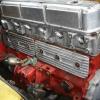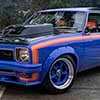opinions on wet sanding primer
#1

Posted 27 December 2007 - 09:18 PM
#2

Posted 27 December 2007 - 09:21 PM
#3

Posted 27 December 2007 - 09:22 PM
#4

Posted 27 December 2007 - 09:32 PM
You may want to go finer than 400 (at least 600 to 800) for a final rub especially if using acrylic as the rub marks (scratches) will show thru the top coat.
Edited by ALX76, 27 December 2007 - 09:32 PM.
#5

Posted 27 December 2007 - 10:14 PM
I know I will need to go finer but right now I am at that point where I need to decide if I will go finer with wet or finer with dry. If I was to go with wet I would be rolling the car out into the sun and letting it dry really well.I find blowing down well with compressed air after wet sanding good enough but i much prefer dry sanding primer, i hate the slop and i can see the lows better.
You may want to go finer than 400 (at least 600 to 800) for a final rub especially if using acrylic as the rub marks (scratches) will show thru the top coat.
painting it 2k as well, not acrylic
#6

Posted 27 December 2007 - 10:27 PM
#7
 _Pete_
_Pete_
Posted 27 December 2007 - 10:40 PM
If it is 2K primer then you won't have any worries of it being "porus" (which is the new term everybody seems to have latched onto to scare others).
I would personally finish off with 800wet with 2K, if your feeling adventurous you could go up to 1000 but I don't think it's necessary.
All you'll need to do is keep an eye out for any "Block" marks, maybe even when your finishing off use a softblock to back up your paper and go over the car lightly to even it up.
Run of the mill paint repairs in a workshop environment typically use 400dry and then 500dry with an Interface pad on a DA to clear up any block marks, BUT that is more for a seasoned painter with plenty of confidence.
#8

Posted 27 December 2007 - 11:23 PM
Please, go on, I am enthralled!If it is 2K primer then you won't have any worries of it being "porus"
#9
 _Pete_
_Pete_
Posted 28 December 2007 - 02:50 PM
Please, go on, I am enthralled!
Now being the internet it's a little hard for me to determine if this is pure sarcasm or not??....I'm going to give the benefit of the doubt and of course explain my reasoning in my previous post.
I'll start by confirming...YES, ALL PRIMERS ARE PORUS, this is a well known fact. There is no way I would recommend bare metalling your car and then painting it in primer and leaving it outside in the rain for 12months. Moisture will get under any primer and rust your car. I'm glad thats out of the way.
2 pack Primer/Putty contains much higher Solids content than any Acrylic Lacquer Primer ever did. Consisting of two parts (Paint and Hardener) gives a much stronger chemical composition compared to the old Acrylic which relied on the solvents (thinners) evaporating to cure. These means the Paint surface will be inherently stronger and if you apply it correctly (typically 4 wet coats with correct flash off times) the substrate (ie. your cars body) will be adequately sealed.
Wet Rubbing a car is a proven technique, anyone who has ever had moisture problems arise in their finished paint surface is looking in the wrong direction if they are going to blame wet rubbing for the result. More than likely it was poor initial surface preparation or water in their compressed air supply when they have painted it.
After you have wet rubbed your car it is good practice to do as the other guys have mentioned and blow it down with compressed air and also leave it in the sun for a few hours to make sure the surface is dry.
Like they say "A little bit of knowledge can be dangerous"...It's always best to ask as many questions and try and learn as much as you can on a subject and learn from others mistakes (which we all make). It's great nowdays with the internet that you can find plenty of information on any given topic.
Who knows?? We all might learn something!!
#10

Posted 28 December 2007 - 04:48 PM
This isn't sarcasm Pete, it's more like paranoia in Heath's case.Please, go on, I am enthralled!If it is 2K primer then you won't have any worries of it being "porus"
He's working in a carport and his car gets wet in the rain.
#11
 _Bomber Watson_
_Bomber Watson_
Posted 28 December 2007 - 05:45 PM
Im not a proper painter, but i do paint drill rigs for a crust.
We get stuff sandblasted, then i give it a flick of 2K primer and it goes off and sits down the back for quiet a while.
Usually it takes at least 6 months for surface rust to start appearing.
Thats crap primer and only 1-2 coats.
Wet rubbing is fine boys.
#12
 _Yella SLuR_
_Yella SLuR_
Posted 28 December 2007 - 09:01 PM
Cohen, I wet sand my primer, and no issues to date.
#13
 _Pete_
_Pete_
Posted 29 December 2007 - 01:19 PM
The normal Dry rub sandpaper is normally a finer finish.
#14
 _Yella SLuR_
_Yella SLuR_
Posted 30 December 2007 - 10:01 AM
Can you make a new topic on sanding and put some pointers down, i.e. types of sandpaper, and tips/tricks to getting a good finish? I think this area is most often overlooked, but most vital to a good paint finish.
#15

Posted 30 December 2007 - 11:05 AM
#16
 _Pete_
_Pete_
Posted 30 December 2007 - 11:47 AM
It might take me a little while to get through as time is scarce but I think it would be cool. Everyone has their own way of doing things so it will make a good conversation piece.
#17

Posted 30 December 2007 - 11:56 AM
It might bust a few myths tooIt might take me a little while to get through as time is scarce but I think it would be cool. Everyone has their own way of doing things so it will make a good conversation piece.
#18
 _HatchmanSS76_
_HatchmanSS76_
Posted 30 December 2007 - 12:05 PM
That would be awsome Pete and much appriciated by so manyI've got a couple of LH/LX guards here that I might do a bit of a Start to Finish "How-To" from Baremetalling, Rust repairs and panel work, priming and then painting.
It might take me a little while to get through as time is scarce but I think it would be cool. Everyone has their own way of doing things so it will make a good conversation piece.
#19
 _tazidvl_
_tazidvl_
Posted 06 January 2008 - 10:43 PM
May be some you tube vids to explain the process but thats asking a lot. Would be good though.I've got a couple of LH/LX guards here that I might do a bit of a Start to Finish "How-To" from Baremetalling, Rust repairs and panel work, priming and then painting.
It might take me a little while to get through as time is scarce but I think it would be cool. Everyone has their own way of doing things so it will make a good conversation piece.
#20
 _Pete_
_Pete_
Posted 06 January 2008 - 10:48 PM
#21
 _@milco@_
_@milco@_
Posted 06 January 2008 - 11:15 PM
#22

Posted 09 January 2008 - 08:40 PM
using a guide coat and a speed file with 120 grit sanded down to find lows and using a hammer and dolly worked them up, guide coating and sanding to see where im at,then gave a light skim of niki over quater guide coated and sanded down until there was no ripples or low spots left,dupont make a epoxy primer that you can do your repairs over and then hifill and guide coat and rub back again using the speed file with 180 grit, then hi fill again same again but just take guide coat of with the 180 then go down to 240 grit dry or free cut paper what ever you what to call it,then once im happy with it (check to see if its straight or like bondi beach)ill rub with 800 wet using little amounts of water,then re guide coat and finish with 1000 grit wet paper and ready to paint,i find it hard to explain,but easier to show people as well,it is alot of work invovled repairing a car that has been stripped back to bare metal and to make sure its done properly aswell,the better your preperation is the better job you will get, you take short cuts they will come back and bite you in the arse
#23

Posted 19 January 2008 - 02:56 PM
I will explain as follows. When it rain falls on your cars paintwork, you can leave your car out to dry when the sun comes out and it leaves no water marks.
However in areas of heavy tap water or even ordinary tap water, if you dont dry off the water dropletts off your newly washed paintwork you can seen water marks left behind.
So when you do wet sanding you must hand dry the surface and even splash a bit of distilled water on the surface to get rid of all the salts and minerals being left behind whilst the water has evaporated.
I know with acrylic painting that when you paint over the mineral and salts that it does show thru over time. It may take many years however with two pac I dont think it would show.
Also primer is porous and whilst the surface may appear dry, it may still have water trapped in the surface. So if you wet sand and then paint 30min later with it just looking dry dont be surprised if years later the surface has crows feet cracks.
1 user(s) are reading this topic
0 members, 1 guests, 0 anonymous users






 View Garage
View Garage










